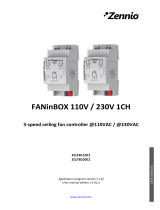CONTENTS
Contents ........................................................................................................................................ 2
Document updates ........................................................................................................................ 3
1 Introduction .......................................................................................................................... 4
1.1 BIN .................................................................................................................................... 4
1.1.1 BIN 44 ....................................................................................................................... 4
1.1.2 BIN 4X ....................................................................................................................... 4
1.1.3 BIN 2X ....................................................................................................................... 5
1.2 Installation ........................................................................................................................ 6
2 Configuration......................................................................................................................... 7
2.1 General ............................................................................................................................. 7
2.2 Inputs / Outputs ............................................................................................................... 9
2.2.1 BIN 44 ....................................................................................................................... 9
2.2.2 BIN 4X / 2X ............................................................................................................... 9
2.2.3 Binary Input .............................................................................................................. 9
2.2.4 LED Lighting Output ................................................................................................. 9
2.2.5 Electronic Relay Control (Heating Actuator) .......................................................... 13
ANNEX I. Communication Objects............................................................................................... 14




























